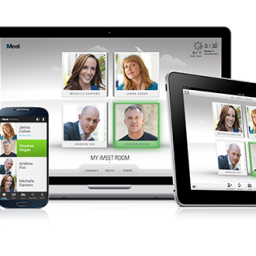Original Post by Dennis Collins
In a recent column for Harvard Business Review (HBR), organizational psychologist and leadership guru Roger Schwarzshares “8 Ground Rules for Great Meetings.” Among them: “Use specific examples and agree on what important words mean.” Doing these two things, Schwarz writes, “ensures that all team members are using the same words to mean the same thing.”
That piece of advice struck a chord with me. Conveying the meaning of important words is my weekly mission, and specific examples are my stock and trade. So, I took a moment to contemplate one of the most frequent topics mentioned on our blog: meetings.
We discuss meetings a lot in our posts. As developers and providers of conferencing and collaboration solutions, we argue frequently and enthusiastically that digital technology has expanded the meaning of “meeting” beyond a group of colleagues talking across a table in one room. From our perspective, any mode of business communication should be considered a meeting – voice, visual, virtual or some combination of the three.
But simply connecting with colleagues in various ways doesn’t define a business interaction as collaborative. Technology can make meetings in any form more efficient — i.e., save participants time and effort, while saving companies expense. Technology alone, however, cannot make meetings of any kind more effective. And to be truly collaborative, an interaction must be efficient and effective.
The terms “efficient” and “effective” are paired so often in conversation – especially business discussions – that blurring the difference between them is easy. So, let’s follow Schwarz’s direction and agree to the meaning of these two important words:
To be efficient means performing or functioning in the best possible manner with the least waste.
To be effective means accomplishing an intended purpose and/or producing an exact result.
This distinction is huge in our world. Efficiency is a key feature of our products and services; helping make teams become more effective is a core value of our company.
In this light, we’d like to share our interpretation of the seven remaining “ground rules” from Schwarz’s HBR piece, as a “specific example” of how to make your collaboration efficient and effective:
1. State views and ask genuine questions
Shift from “monologues and arguments to a conversation” that includes everyone’s point of view and constructive curiosity about the differences between perspectives.
2. Share all relevant information
Enable team members to solve problems and make decisions by “developing a comprehensive, common set of information.”
3. Explain reasoning and intent
Explore how participants reached their conclusions and how individual thinking differs.
4. Focus on interests, not positions
Reduce conflict and increase commitment from team members by identifying needs rather than arguing preferences.
5. Test assumptions and inferences
Question detached observations rather than personal beliefs and motives.
6. Jointly design next steps
Commit to moving forward as a team before parsing assignments.
7. Discuss undiscussable issues
Bring difficult matters to the surface as a group when differences can be resolved together.
At first glance, Schwarz’s rack of rules seems like heavy lifting that would encumber meetings rather than streamline them. To avoid this problem, we recommend issuing a brief policy statement to staff – a sort of “Meeting Manifesto.” This concise document will serve as a tangible reminder for future reference and should contain at least these three guidelines:
- Explicitly agree on ground rules and what each one means
- Agree that everyone is responsible for helping each other adhere to the rules
- Discuss how the rules are applied and how to improve them
The net effect of these few additional meetings will be raising the effectiveness of all meetings – and the overall impact of collaboration in your organization. If you want to check out some of the best collaboration software (as well as try out some free trials), click here!

